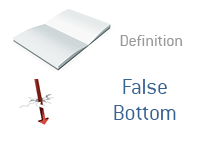Definition of False Bottom
What is a "false bottom" in the world of trading and investing? What does the term "false bottom" mean?
A "false bottom" occurs when people believe that a "bottom" (temporary low) has been found in a stock or other asset, only for the value of the asset to continue falling further.
 Let's use an example to fully illustrate the proper usage of the term "false bottom":
Let's use an example to fully illustrate the proper usage of the term "false bottom":XYZ, Inc. is currently trading at $55. The stock has a 52 week low of $33.50, and a 52 week high of $67.
XYZ, Inc. reports their Q3 earnings, and the stock falls dramatically the next day. After opening at $44, shares of XYZ, Inc. end up closing the day at $42.
After the next couple of months, shares of XYZ, Inc. briefly hit $40 multiple times before bouncing back to $43-$44. This leads many investors to believe that the bottom for XYZ, Inc. is $40, and that there is not much chance that the shares dip below that price.
Unfortunately for XYZ's shareholders, the $40 level turns out to be a "false bottom". In the week leading up to XYZ's Q4 earnings report, investors get nervous and start dumping shares. Shares of XYZ take out the $40 and eventually settle at $32 before the company releases its earnings.
--
Davemanuel.com Articles That Mention False Bottom:
None
